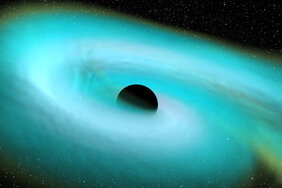Neutron stars typically have a mass below 2 times the mass of the sun, while most of the black holes have a mass in excess of 5 solar masses. This has led to the claim of the existence of a mass gap between the maximum neutron star mass and the minimum black hole mass. In May 2023, the LIGO-Livingston gravitational wave detector observed a signal called GW230529 from the merger of a neutron star with a compact object whose mass falls into this previously deserted mass range.
"This exciting discovery of a compact object with a mass between the heaviest known neutron star and the lightest known black holes brings crucial insights about the evolution of massive binary stars" explains astrophysicist Prof. Dr Michela Mapelli. Michela Mapelli, professor for computational astrophysics at Heidelberg University since July 2023, is one of the lead scientists behind analysing and interpreting the gravitational wave signal GW230529 within the LIGO-Virgo-KAGRA collaboration.
Before the first detection of gravitational waves in 2015, the masses of stellar black holes and neutron stars were mainly determined by X-ray and radio observations. The derived masses fell into two distinct regions, separated by a gap of about 2 to 5 times the mass of our Sun. The analysis of the signal GW230529 now shows that it comes from the merger of two compact objects, one with a mass between 1.2 and 2.0 solar masses and one with a mass more than twice as massive, which thus fall into the mass gap. Although gravitational-wave observations have now provided nearly 200 measurements of the masses of compact objects, only one further merger could involve a compact object within the mass gap.
"The range between 3 and 5 solar masses is no longer a lonely desert, although it might still be less populated than other regions of the compact-object mass function. More than 8 years after their first detection, gravitational waves still surprise and challenge us", Mapelli raves about the prospects of gravitational wave astrophysics. Michela Mapelli is principal investigator of the DEMOBLACK ERC consolidator project. DEMOBLACK is the acronym for "Demography of black hole binaries in the era of gravitational-wave astronomy" and aims to shed light on the formation channels of binary black holes by means of innovative numerical models.
The merger of a neutron star with a black hole that emitted the gravitational wave signal GW230529 most likely took place about 650 million light-years from Earth. Unfortunately, the source is poorly localized on the sky as only one gravitational wave detector was operational at the time of the signal. But after a commission break the fourth observing run resumed on April 10, 2024 with the detectors LIGO Hanford, LIGO Livingston and Virgo working together. It will now continue until February 2025. By this end, the total number of observed gravitational wave signals should increase from 80 to about 200. It will be exciting to see what surprises the universe has in store for us and whether the mass gap will continue to be filled.
ABOUT GRAVITATIONAL-WAVE OBSERVATORIES
LIGO is funded by NSF and operated by Caltech and MIT, which designed and built the project. Financial support for the Advanced LIGO project was led by the NSF, with significant pledges and contributions from Germany (Max Planck Society), the UK (Science and Technology Facilities Council) and Australia (Australian Research Council). More than 1,600 scientists from around the world are participating in the effort as part of the LIGO Scientific Collaboration, which includes the GEO collaboration. You can find more partners at https://my.ligo.org/census.php.
The Virgo Collaboration currently consists of approximately 880 members from 152 institutions in 17 different (mainly European) countries. The European Gravitational Observatory (EGO) hosts the Virgo detector near Pisa in Italy and is funded by the Centre National de la Recherche Scientifique (CNRS) in France, the Istituto Nazionale di Fisica Nucleare (INFN) in Italy, and the National Institute for Subatomic Physics (Nikhef) in the Netherlands. For a list of Virgo collaboration groups, see: https://www.virgo-gw.eu/about/scientific-collaboration/. For more information, visit the Virgo website at https://www.virgo-gw.eu.
KAGRA is the laser interferometer with 3 km arm length in Kamioka, Gifu, Japan. The host institute is the Institute for Cosmic Ray Research (ICRR) at the University of Tokyo, and the project is co-hosted by the National Astronomical Observatory of Japan (NAOJ) and the High Energy Accelerator Research Organization (KEK). The KAGRA collaboration consists of over 400 members from 128 institutes in 17 countries/regions. KAGRA's information for a general audience can be found on the https://gwcenter.icrr.u-tokyo.ac.jp/en/ website. Resources for researchers are available at http://gwwiki.icrr.u-tokyo.ac.jp/JGWwiki/KAGRA.
RELATED ORIGINAL PUBLICATION
The LIGO Scientific Collaboration, the Virgo Collaboration, and the KAGRA Collaboration "Observation of Gravitational Waves from the Coalescence of a 2.5–4.5 solar bodies Compact Object and a Neutron Star", please note that the names of the authors will appear in the version accepted by the AAS (see doi.org/10.48550/arXiv.2404.0424)
LEARN MORE
LIGO-Virgo-KAGRA (LVK) Collaboration
SCIENTIFIC CONTACT
Prof. Dr Michela Mapelli
Centre for Astronomy of Heidelberg University (ZAH)
Institute for Theoretical Astrophysics (ITA)
mapelli@uni-heidelberg.de
Homepage: demoblack.com
CONTACT FOR THE MEDIA
Dr Guido Thimm
Centre for Astronomy of Heidelberg University (ZAH)
thimm@uni-heidelberg.de

